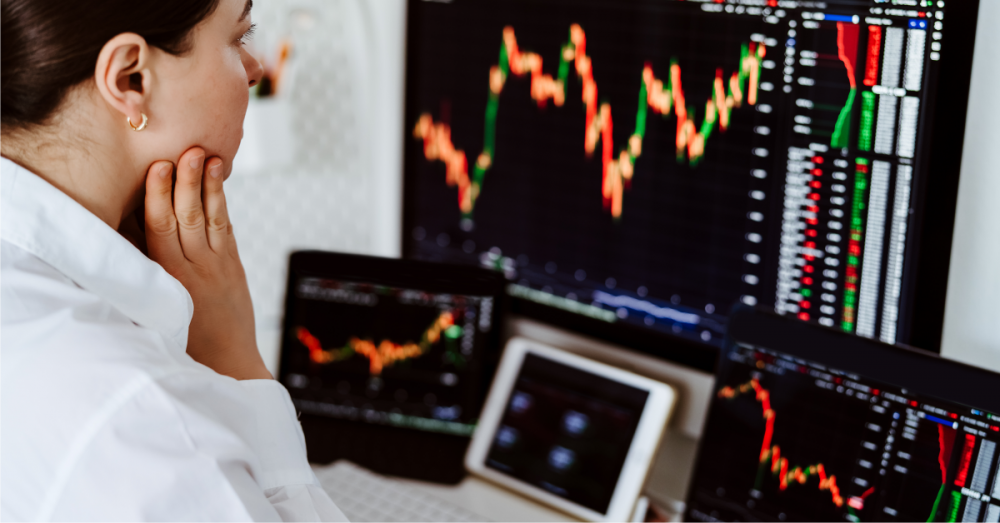As an investor, with the expectation of a future financial gain, you choose to allocate capital. If engaging in crypto-margin trading is your first time, understanding the things involved in it is vital. Margin trading is a risky and challenging route, but you also get a chance to make big money. Here's a margin trading guide for you to make cryptocurrency trading profitable, learn what is margin trading, and to remember the risks associated with it.
What is buying on Margin?
To define marginal trading, it requires money from a lender to purchase stock. In other words, it's a borrowing you can get from a customer buying and selling goods or property. The strange thing about margin trading is that you can buy more shares than you would usually be able to buy.
As long as you want, you can retain your loan if you meet your commitment— you have to pay interest on your loan. At first, the lender will earn the proceeds to repay the loan until it is fully paid.
As interest charges accumulate against you, your liability increases over time. In other words, the interest charges always increase as the debt increases, and so on.
Margin trading requires an account with a margin. It's a separate investment account than a regular cash account. By law, to open a margin account, the trader must obtain your signature. It can be a wholly detached arrangement, or it can be part of your default agreement to open your account.
You must deposit cash or assets when you purchase on leverage finance to serve as a guarantee to cover the risk of such transactions. The initial margin is called this process. Once you have opened the margin account, you can borrow up to 50% of a stock's purchase price. Many investors usually borrow from 10% to 25%.
Note: Some brokerages require investors to deposit more than 50% of the purchase price. It is also not possible to buy all stocks on the margin. Individual brokerages have the right to marginalize and not select certain stocks. It's best to check to determine the limitations on your margin account with your brokerage.
Cryptocurrency margin trading allows users to short bitcoin on an exchange against their current funds to sell "on margin" cryptocurrency. To put it differently, users can exploit their current cryptocurrency such as short bitcoin or dollars by taking some money to raise their purchasing power (usually giving interest on the borrowed sum, not necessarily every time)
For instance, you're putting down $25 and leveraging $75 to buy short Bitcoin worth $100. The only stipulation is that you will have to pay back $75 plus fees regardless of what happens. To ensure that they receive back the borrowed sum, an exchange will usually "call in" your margin trade as you reach a price where you would being loosing the loaned money (since they’ll allow you to short bitcoin to trade, but however they will not be thrilled to lose that money). You can avoid a margin call by adding more money in the same place.
Specific leveraging options can be available for a given exchange. Margin trading can take place shortly (where you put money on the downward price) or longly (where you put money on the upward price). Margin trading can also be used to speculate, hedge, or dodge having to maintain an exchange with your full balance.
Example of a Buying Power
Once you have learnt what margin trading is, you need to see some examples to know better. If you deposit $15,000, which is 50 percent of the purchase price, into your margin account, your "buying power" is worth $30,000. If you decide to buy $10,000 worth of stock, $20,000 would be your remaining buying power. You've got plenty of cash to cover this offer because you haven't hit your margin. A situation where you start borrowing money is when you choose to buy more than $15,000 insecurities.
Note frequent fluctuations in the purchasing power of a margin account. The value depends on the variation of prices of the account's marginable securities. That's why understanding the stock market's inevitable volatility is essential.
What is a Margin Call?
This situation occurs when the margin account is expected to reach the minimum maintenance margin when the account price falls below the minimum required value of the trader. A broker asks for more cash or bonds to be invested by a stakeholder to satisfy the need. In other words, some of the assets held to run up the account are supposed to be sold by the lender.
The percentage of service margin is usually 25%. But among brokers, it can vary.
How Does Margin Call Work?
After defining marginal trading, let’s move onto margin call work. One of an investor's viable options for making investments is to ask a broker for a loan. This is called the Margin Call process. He pays for them by using margin to buy or trade securities through combined funds— the funds and the money borrowed from a trader. Here is how the investor's equity can be calculated:
Investor's equity = market value of securities – loan from a broker.
What Happens if the Margin Call is Not Met?
A broker can close any open positions without your approval to restore the account's minimum value. Besides this, you may be charged on transactions for a commission. You will be responsible for any persistent losses during the process.
Tip: Using shielding stop commands is a perfect way to dodge margin calls. In this way, losses from any equity position can be limited. Also, through stop orders, you can keep enough cash and securities in the account.
Use your deposit to short bitcoin to take advantage of your investment. If you have an effective strategy, and if the odds are in your favor, leveraging can also help you gain more profits.
Here's an instance: you can hold a position of 2:1 leverage finance, which is twice the price of your trading account. For example, you'd be able to buy $20,000 worth of stock if you had $10,000 in your trading account. This can be achieved by swap lending funds or some other lenders.
The loan carries fees and interest to be settled at some point to avoid higher charges.
Where to Margin Trade Cryptocurrencies
Poloniex, Bitfinex, Kraken, Bitmex, and Bluebelt are some of the big exchanges where you can find margin trading. So far, with Bluebelt, a reliable cryptocurrency exchange platform based in Asia, many dealers and investors are getting satisfaction. It operates under global brands, namely the Bluebelt Exchange Group, created by financial professionals and talented ITs from Japan. Besides, a new trade and exchange policy through Crypto-Fiat was introduced in December 2018. It already has 100x flexibility to help you boost your profits.
How to Become Successful in Margin Trading
In margin trading, the secret to success is to pursue a slower approach. Take time to learn all the things mentioned above. It is essential to test their terms and conditions before you register for an exchange and make a deposit. Others are flexible, but in allowing margin trading, some transactions have strict criteria.
Going forward, you can then build a margin trading strategy once you become aware of the technical analysis of price action. Eventually, you're going to be an accomplished trader with a strong personality that can avoid calling margins and conquer the unavoidable volatility.
Play safe
Now, find a "margin trading site" to provide you with a good experience that can provide you with ease in handling deposits such as Bluebelt.
Margin buying requires lending money to buy stock from a broker. A margin account helps flourish your purchasing power and enables you to increase financial leverage by using someone else's money. Margin trading provides a higher potential for profit than traditional trading, but also more significant risks. Buying limited stocks increases the effect of losses. Besides, a broker may send out a margin call that will require you to close down your position in a stock or front of more capital to support your investment.
Assume you have $10,000 in your margin account, but you still want to purchase more stock. The Federal Reserve has a preliminary margin requirement of 50 percent, which means that for a stock purchase, you have to front at least half of the cash. That condition gives you the ability to buy up to a stock value of $20,000, effectively doubling your buying power.
You own $20,000 in stock after you make the purchase, and you owe $10,000 to your broker. The stock's value is used as collateral for the loan it gave you. If the stock price falls to $30,000 and you sell it, after paying back the broker (plus interest), you can retain what remains. Your gains are equivalent to $20,000 (minus interest charges) for a $10,000 initial investment profit of 100 percent. If you paid yourself for the whole $20,000 and priced at $30,000, your profits were only 50%. This example shows how the leverage finance provided by margin purchases of compound benefits.
At the same time, leverage finance amplifies losses. Think the stock price is down to $15,000, and you are selling it to avoid further losses. Upon paying the $10,000 you owe him to your broker, your profits would hit $5,000. Half of your original investment was lost. However, with traditional investment, a price drop from $20,000 to $15,000 represents a loss of only 25 percent.
The threat of moderately buying stocks is the dreaded demand for margins. The Federal Reserve also requires a maintenance margin of 25% in addition to the initial margin requirement of 50%. You must always have an equity of 25 percent in your margin stocks. Your broker margin arrangement can require a higher maintenance margin than the minimum of the Fed. When the price of your stock falls below the rate mandated by the Fed or your broker, you may receive a margin call that allows you to raise your capital by liquidating stock or adding more cash to your account.
Going back to the above example, assume that the maintenance margin requirement of your broker is 40%. Because you owe $10,000 to your broker, a fall in the stock price from $20,000 to $15,000 will lower your equity to $5,000. That's just 33% of the stock price–you've fallen below the average of 40%. If you are unable or unwilling to contribute more capital to the margin call, your broker is entitled to sell your stock, and your consent is not required.
Should I Do Margin Trading?
It is highly advised that you don’t come near margin trading until you have jotted adequate information, are veteran and have a particular motive, such as hedging. Losing cash trading short bitcoin is already nerve-wracking to create leveraged financial positions without having to borrow funds plus interest. It increases your level of stress.
Of course, if you are not as cautious as we are and would like to trade on the margin nevertheless, your next move should be to thoroughly read all the margin trading information available for any particular exchange prior to beginning. The next step is to understand how open and close margin spots, and to comprehend margin relations and calls, as well as polishing on some margin trading approach. We're going to assume you're already familiar with technical measures.
WARNING ON RISKS, RATIOS, AND BET SIZE: Crypto currency margin trading is one of the unsafe gambles you can make. Crypto currency can be very volatile, and there is a risk margin trading. Set them together on a highly leveraged finance and you could very soon find yourself owing a lot of money (exceptionally high volatility altcoins with low volume). You are also at the risk of losing all of your starting investment margin tradings as opposed to regular trading. Moreover, the faster you can lose it, the more you leverage the finance. Take this as an instance, if you go long on a 4:1 margin and the position decreases from about 25 percent from where you opened the position (less because you possibly owe fees), the margin will be invoked, and you will be left empty handed.
Think about it this way; a person is putting down $25, he/she has borrowed $75, so they’ve just got a little under $25 to lose the $100 that you're gambling on. If it goes up, he/she can hold the place open for as long as they like (as you don't lose $75 from the lender), but if it goes down the account will be dissolved reliant on the rate at which you are leveraged with finance if you do not add more money in it.
Do a leveraged financial 8:1 position, and it will be called at around 12.5 percent twice as fast, do a 2:1 position, and it will be called up at approximately 50 percent. Yes, to prevent it from closing, you can always add to your position, but this is the precise kind of rabbit hole that loses money to people. You must look at the Reddit post "Why I Lost Nearly 200 BTC Trading this past month" for a compulsory reality check and reasonable notice of advantages and dangers of margin trading.
Margin trading and taxes. Margin traders make capital gains and losses in the short run and are therefore/ focusing on capital gains tax for a short term (their rate and the requirement to report trades and quarterly payments, both included). However, traders who have crypto can escape this and can enjoy long-term levels of capital gains if they stay long enough. There are many advantages and disadvantages to consider when contemplating what is margin trading for you.







